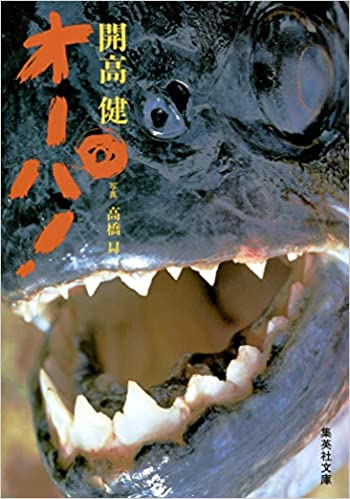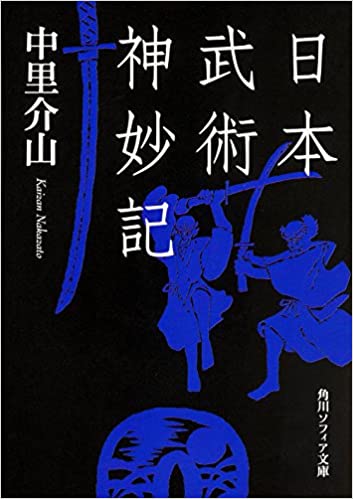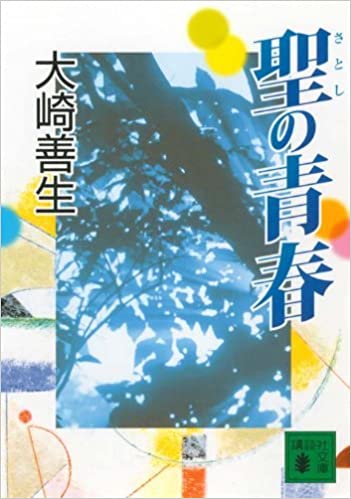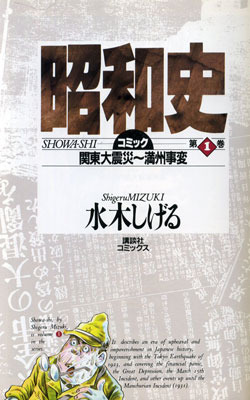Chitanda Eru’s Bookshelf | Contents | Ibara Mayaka’s Bookshelf

Note from Yonezawa-san: I thought it would be easy to decide on these books since Satoshi holds an interest in everything, but when I started making a rough list, I noticed that the books would not make up a mere superficial bookshelf, and that I’d given it a relatively high level of consideration. Also, I had the realization that Satoshi probably bought old books at a cheap price and has been reading them for a long time, which could serve as an entrance to even deeper interests and cultures, so the selection was smooth compared to the rest. As Satoshi continues reading these good books, I imagine that the day will eventually come, when he decides on the direction he wants to take his interests in.
(The order the books are listed is right to left, top to bottom)
First page

Sherlock Holmes of Baker Street (William S. Baring-Gould)
A book that purports to be a “definitive” biography of Sherlock Holmes. Some aspects were loosely based on the life of the author’s paternal grandfather, Sabine Baring-Gould, and many of the theories put forth have become accepted knowledge about Sherlock Holmes. (Source: Wikipedia)
Opa! (Written by Takeshi Kaikō, Photographs by Takahashi Noboru)
A non-fiction book that documents a fishing adventure in the Amazon. The writer and his photographer chases after the giant pirarucu, meat-eating piranha, golden dorado and the famous tucunare, with “Opa!” being an exclamation of surprise from such a rich, deep, interesting and legendary journey. (Source: Amazon)


Phantoms in the Brain: Probing the Mysteries of the Human Mind (Sandra Blakeslee, Vilayanur S. Ramachandran)
In this popular science book, Dr. Ramachandran recounts how his work with patients who have bizarre neurological disorders has shed new light on the deep architecture of the brain, and what these findings tell us about who we are, how we construct our body image, why we laugh or become depressed, why we may believe in God, how we make decisions, deceive ourselves and dream, perhaps even why we’re so clever at philosophy, music and art. (Source: Goodreads)
Lineage of Eccentrics: Matabei – Kuniyoshi (Nobuo Tsuji)
Lineage of Eccentrics: Matabei – Kuniyoshi, published in 1988 by Perikansha Publishing, offered a reappraisal of the artistic practices of Iwasa Matabei, Kano Sansetsu, Ito Jakuchu, Soga Shohaku, Utagawa Kuniyoshi, artists who had been considered peripheral to Japanese art history up to that point. By focusing on these artists, Tsuji was able to revive present day interest in their work and spirit. (Source: Amazon)


Classroom of Infinite Theory (Shigeki Noya)
Many paradoxes are made up of mysteries that contend with “infinity”. Why can’t Achilles catch up to the tortoise?1 Are there really as many even numbers as there are natural numbers?2 This unique philosophy classroom introduces paradoxes from commonplace problems to Gödel’s incompleteness theorem in a lightly humorous manner. (Source: Amazon)
Battlefield of the Mercenaries: New Edition (Hisashi Fujiki)
During the Sengoku period, which was rife with famine and war, the battlefield of heroes was filled with looting and kidnapping. Mercenaries hunted for slaves in warzones, as the battlefield was one of the only places to earn money for those who could not survive even on subsistence farming. Those were the struggles of people in a war that continually reduced the total population, but then the battlefield eventually started closing off with the unification of the country… (Source: Amazon)


Do You Know Greek Mythology? (Takashi Atōda)
Greek mythology, which is treated as a classic of the classics along with the Bible, has brought about a significant impact to the world’s ideas, art and literature. This book expertly deals with the major issues in a variety of stories, explaining each episode in a manner that is easy to understand. Eros, Oedipus, Pandora, Andromeda… By reading this book that delves into the fates of those heroes and heroines, you have become a connoisseur of Greek mythology. (Source: Amazon)
World History of Tea (Sakae Tsunoyama)
In the 16th century, Europeans visited Japan and developed a deep admiration for the art of the tea ceremony. Entranced and yearning for tea, the modern era for Europe began, and the English started their unique culture for black tea. Stimulated by tea and cotton, capitalism soon reached the Orient. However, when Japan’s tea was suddenly released the world, it was clearly a failure as a product. This book will tell you about the contents of that teacup in your hands, or the product that moved the world. (Source: Amazon)


Whoever Fights Monsters: My Twenty Years Tracking Serial Killers for the FBI (Robert K. Ressler, Tom Shachtman)
Face-to-face with some of America’s most terrifying killers, FBI veteran Robert K. Ressler learned how to identify the unknown monsters who walk among us — and put them behind bars. In Whoever Fights Monsters, Ressler shows how he was able to track down some of the country’s most brutal murderers. (Source: Amazon)
One More Slow Curveball (Junji Yamagiwa)
A baseball player hits a home run at Koushien, a feat he has never achieved before. A series of pitches in the ninth inning that will go down in sporting history as Enatsu’s 21 Pitches3. This book documents 8 episodes that capture the brilliance of the sport. (Source: Amazon)


Orthodoxy (G. K. Chesterton)
This book is meant to be a companion to “Heretics”4, and to put the positive side in addition to the negative. Many critics complained of the book because it merely criticized current philosophies without offering any alternative philosophy. This book is an attempt to answer the challenge. It is the purpose of the writer to attempt an explanation, not of whether the Christian Faith can be believed, but of how he personally has come to believe it. (Source: Goodreads)
Philosophy for “Children” (Hitoshi Nagai)
This is a good book to learn philosophy on your own from scratch. Why should we not do bad things? Why do I exist? Is there an answer to these questions? By challenging your mind, this book guides you in the process of finding your answer. (Source: Amazon)


Maxwell’s Demon: From Probability to Physics (Takuji Tsuzuki)
Maxwell’s Demon can freeze the water in a boiling kettle. It can make the time machine a reality, by bringing back the past, and setting it in perpetual motion. If human race is to be eradicated, if the universe meets its demise, wouldn’t Maxwell’s Demon be the savior? This book gives a simple, interesting explanation about entropy, which determines the direction that time travels, while keeping an eye on the mysterious demon. (Source: Amazon)
Chūkaku vs kakumaru (Takashi Tachibana)
An analysis of the violent conflict between Chūkaku5 and Kakumaru6 factions during the early 1970s, including an interview with Chūkaku general secretary Nobuyoshi Honda. (Source: Wikipedia)


The Corpses Speak (Masahiko Ueda)
Can you hear the message of the dead? Disguised murders, suicides disguised as murders, bizarre murders… no matter how much you try to hide the truth, the speechless corpses will eloquently convey the human hate and anguish lurking behind the scenes. Listening to the dead’s voice, diligently conducting an autopsy, and investigating the cause of death by dissecting the body is the job of a medical examiner. This bestselling book is a bible for people who want to get into forensic science. (Source: Amazon)
Second Page
Aphorisms by a Pygmy (Ryūnosuke Akutagawa)
A collection of essays and aphorisms by Ryūnosuke Akutagawa7, although in his own words, it does not necessarily convey his philosophy, but merely reveals the transformations that sometimes occurs in his thinking. (Source: Wikipedia)


Murphy’s Law: The 26th Anniversary Edition (Arthur Bloch)
For more than a quarter of a century, Murphy’s Law has provided the last word on things going wrong. Positive thinking is all very fine when the world is treating you right, but when things go awry, it’s Murphy’s Law that comes up with the goods: the pithy revelations and undeniable truths that document our limitless potential for misplaced insight, hopeless wit, and pessimistic wisdom. This special anniversary collection features the best of Murphy’s Law – plus new 21st-century entries proving that with advances in technology, even more can go wrong. (Source: Amazon)
The Man who Gave a Lance to a Meijin (Kōzō Masuda)
An autobiography that documents the dramatic life of Kōzō Masuda, the man who gave a lance8 to a meijin9 and won, from his youth when he ran away from home, his vagrant life in Hiroshima, his apprenticeship under Kimi Kinjirou (then an 8-dan) in Osaka, meeting his lifelong rival Yasuharu Ōyama, the hard-fought battle against Yoshio Kimura, the truth of the Jinya Incident10, as well as the fulfillment of his lifelong dreams. (Source: Amazon)


Great Detectives Who’s Who (Joukichi Hikage)
Would you like to know some great detectives? One century after Poe, we have the famous Sherlock Holmes, Hercule Poirot, Ellery Queen, Philip Marlowe, Jules Maigret, Dr. Poggioli… This book introduces 50 detectives from the colorful realm of mystery. (Source: Blurb11)
Japan Martial Arts Chronicles (Kaizan Nakazato)
A compilation of interesting anecdotes of people well-known for being at the top of their craft, in the fields of swordsmanship and spearmanship, and even in jujutsu and the art of the naginata12. This masterpiecce the source of legendary episodes that spread in later years. (Source: Kawade Shobo Shinsha)


Birth of the Reikyūsha (Shoichi Inoue)
What were the circumstances around the birth of the reikyūsha13 that resembles a small Buddhist shrine, and how did it spread around the country? This is the only book that explains the changes of Japanese funerals with the advent of the reikyūsha. (Source: Amazon)
Satoshi’s Youth (Yoshio Ohsaki)
A non-fiction book filled with master-disciple love as well as familial love, detailing the life of Satoshi Murayama, who struggled with nephrotic syndrome14 and collapsed from bladder cancer before he could fulfill his dream of becoming a meijin. (Source: Amazon)


Obedience to Authority: An Experimental View (Stanley Milgram)
A book concerning a series of experiments on obedience to authority figures he conducted in the early 1960s, in which human subjects were instructed to administer what they thought were progressively more painful electric shocks to another human being to determine to what extent people would obey orders even when they knew them to be painful and immoral. This book provides an in-depth look into his methods, theories and conclusions. (Source: Wikipedia)
Senjutsu Chōkōkaku Orion (Masamune Shirow)
In the mighty Yamata Empire, magic and technology are one and the same. Now the Empire is preparing its ultimate feat of psycho-science: the destruction of all the negative karma in the galaxy. But will this mystical purification be the salvation of humanity — or its ultimate destruction? Only one being can save the Empire from its folly: Susano, the God of Destruction. Wild, arrogant, and homicidal, Susano has come to teach the world the true nature of power! Masamune Shirow, creator of Appleseed, Dominion, Intron Depot, and Ghost in the Shell, has built a rabid worldwide following with his unique, eclectic, and visually stunning blend of science-fiction and fantasy. (Source: Goodreads)


The Adventures of Sherlock Holmes (Arthur Conan Doyle)
A collection containing the earliest short stories featuring the consulting detective Sherlock Holmes, including A Scandal in Bohemia, the only story to feature Irene Adler, who is often portrayed as Holmes’ love interest in modern adaptations (Source: Wikipedia)
Fifty-Two Honba15 in the First Round (Takehiro Irokawa)
Mahjong is all about self-confidence. That was what the youth believed. In his first tournament, the youth challenged a pro known as an icon among those in the trade. The game would last four rounds. The youth had a good start, but… This short story anthology depicts the intensity and fear in a game of Mahjong. (Source: Amazon)


Samurai Non Grata (Toshihiko Yahagi and Jiro Taniguchi)
“One-man trading firm” Hongou Yoshiaki and “former captain of the French Foreign Legion” Norimizu Rintarou come to life in this “comedy movie drawn on paper” filled with humor and action and complete with beautiful girls, with Paris as the backdrop. (Source: Amazon)
Belle ☆ Starr’s Band of Outlaws (Akihiro Ito)
To protect the people she loves (and their land), the girl pulls the trigger of the revolver. This is an elegy to the outlaws who could only live on the dusty, lawless Western Frontier. Now, let the story of the legendary train robber Myra Belle Shirley, also known as Belle Starr, begin. (Source: Amazon)


Happy Tiger (Motofumi Kobayashi)
The story of a young, happy-go-lucky Japanese officer over the course of World War II. In 1940, he goes to Mongolia to help a nomadic family who rescued him during the Soviet-Japanese War of 1939. He decides to live with his Mongolian friends, but he is accidentally conscripted into the Red Army. At the Battle of Moscow in 1941 he becomes a prisoner of war of the Germans, but eventually is allowed to join the Waffen-SS, in which he becomes a Tiger tank crewman. And that’s just the start of his adventures… (Source: Animelist)
Shōwa: A History of Japan (Shigeru Mizuki)
A semi-autobiographical work, this manga describes the author’s experiences growing up during the Shōwa period16. The author is a veteran of the Japanese army, but his series is filled with critical views of Japanese and American militarism. (Source: Wikipedia)

Chitanda Eru’s Bookshelf | Contents | Ibara Mayaka’s Bookshelf
Editors (Tier 2) : Joshua Fisher, Slush56, Jen Murph, _Maki
Assistants (Tier 1) : Karen Kronenberg, Definitelynotme, Rolando Sanchez, Kevin Kohn, Jaime Cuellar, Yazmin Arostegui
Thank you very much for all your support!
- In this paradox, Achilles and a tortoise are in a footrace. Whenever Achilles arrives somewhere the tortoise has been, he still has some distance to go before he can even reach the tortoise, so it appears that he can never catch up to the tortoise.
- This webpage sums the paradox up quite well.
- With a one run lead in the bottom of the ninth, Enatsu loaded the bases with nobody out. He got the first batter, then perfectly read the squeeze attempt to get the second runner before striking out the man at the plate to preserve the lead and earn his team its first title.
- A collection of 20 essays originally published by G. K. Chesterton in 1905. The topics he touches upon range from cosmology to anthropology to soteriology and he argues against French nihilism, German humanism, English utilitarianism, the syncretism of “the vague modern”, Social Darwinism, eugenics and the arrogance and misanthropy of the European intelligentsia.
- Meaning “middle core faction”, Chūkaku was a far-left revolutionary group that aimed to have Japan and the entire world adopt communist policies, although they were fervently anti-Stalinist. They split from the Japanese Revolutionary Communist League National Committee in 1963.
- Meaning “revolutionary Marxist faction”, Kakumaru was a Japanese Trotskyism revolutionary group that split from the Japanese Revolutionary Communist League National Committee in 1963.
- A Japanese writer active in the Taishō period in Japan, regarded as “father of the Japanese short story”.
- A lance is a piece in shogi that can only move forward in a straight line. “Giving a lance” in this case means playing with one less lance as a handicap.
- One of the eight titles in Japanese professional shogi, and is the most prestigious title.
- On February 18 in 1952, there should have been a first lance handicap title match game between Yoshio Kimura and Kōzō Masuda, since Masuda led the Osho title match by 4-1 at that time. However, Masuda rejected to play the game. The reason of his rejection was not clear. They say he worried about hurting the authority of meijin by giving a handicap to Kimura who held the meijin title at that time.
- It seems that Yonezawa picked a really obscure book. I couldn’t find any information on it even on Japanese sites, so I had to rely on the blurb.
- A pole weapon originally used by the samurai of feudal Japan, as well as foot soldiers and warrior monks.
- A reikyūsha is basically a hearse used to carry the dead body of a person for a funeral, but the vehicle is fitted with an ornament that usually looks like a small Buddhist shrine. Click here for a picture of what it looks like.
- A collection of symptoms due to kidney damage. This includes protein in the urine, low blood albumin levels, high blood lipids, and significant swelling. Other symptoms may include weight gain, feeling tired, and foamy urine. Complications may include blood clots, infections, and high blood pressure.
- Honba is an added element to scoring that awards bonus points for particular repeats, which increases by one for the next hand when no player manages to win, or when the dealer wins the hand. When any non-dealer wins a hand, then the honba count resets back down to zero.
- Refers to the period of Japanese history corresponding to the reign of Emperor Shōwa (Hirohito) from December 25, 1926 until his death on January 7, 1989.

Pingback: Chitanda Eru's Bookshelf - Pigcow Translations
Pingback: Ibara Mayaka's Bookshelf - Pigcow Translations
I am glad to be one of many visitors on this great site (:, appreciate it for posting.